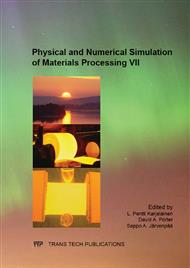p.360
p.368
p.374
p.382
p.387
p.392
p.398
p.405
p.411
Numerical Simulation of Bubble Migration in Liquid Titanium Melts under Hypergravity Field
Abstract:
Bubble migrations in liquid titanium melt under hypergravity field is modeled using commercial computational fluid dynamics software FLUENT 6.3 (Fluent inc., USA). The two-phase fluid model, incorporated with the Multiple Reference Frames (MRF) method is used to predict the movement of the bubble in the melt. Simulated results are compared with experimental data from the water model measurement and reasonable agreements are obtained. Furthermore, the computed results show that the bubble migration under hypergravity field includes the movement forward to the casting rotating shaft and the movement opposite to the direction of the rotating mould. In addition, the initial bubble size and the surface tension between the melt and the gas bubble have an important effect on the distortion of the bubble.
Info:
Periodical:
Pages:
387-391
Citation:
Online since:
July 2013
Authors:
Keywords:
Price:
Сopyright:
© 2013 Trans Tech Publications Ltd. All Rights Reserved
Share:
Citation:


